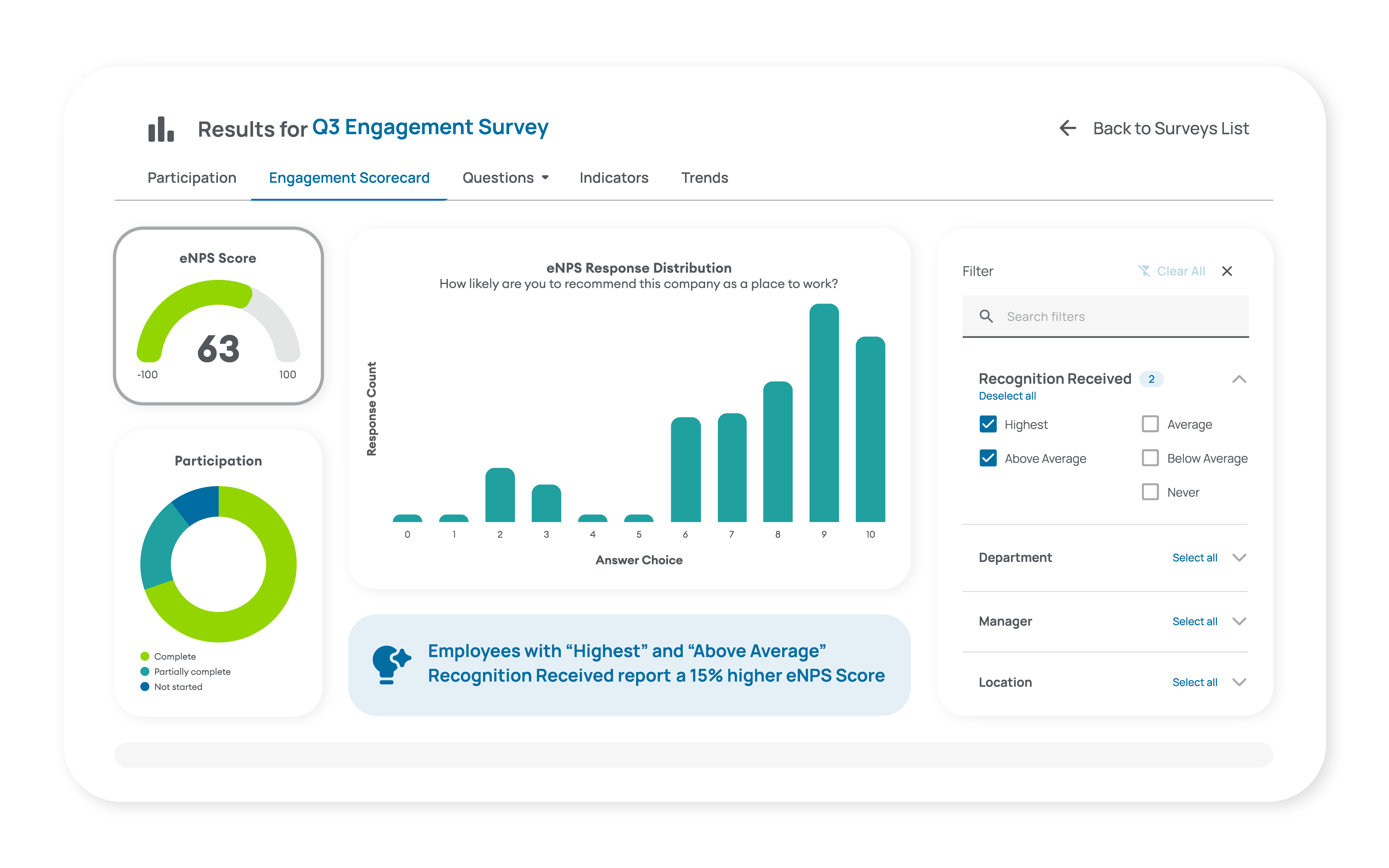June 6, 2025

Wondering about the difference between recognition and appreciation? You’re not alone. In the workplace, the topic of recognition vs appreciation highlights how these two concepts play distinct but complementary roles. Appreciation values employees for who they are, while recognition focuses on their specific achievements.
Understanding ‘appreciation vs recognition’ can transform your workplace culture. This article explores these differences and explains why both are essential.
Key Takeaways
- Recognition celebrates specific achievements, while appreciation emphasizes the inherent value of individuals, creating a balanced workplace culture.
- Combining recognition and appreciation enhances employee motivation and engagement, resulting in higher job satisfaction and reduced turnover.
- Frequent expressions of appreciation make employees feel valuable, which significantly impacts their productivity and loyalty, making it a crucial component of a successful business strategy.
While recognition and appreciation differ, each plays a unique role in the workplace. Recognition is typically given for specific achievements, while appreciation is a broader expression of gratitude for the individual.
Employee recognition centers on work-related accomplishments, making it a powerful tool for motivating employees and aligning their efforts with the company’s goals. Appreciation, however, emphasizes the person's inherent value, celebrating their qualities and efforts beyond just performance metrics.
Their delivery methods tend to also differ. Recognition is often formal and structured, such as awards or certificates, acknowledging tangible accomplishments. In contrast, appreciation tends to be more informal and spontaneous, like a heartfelt thank-you note or verbal praise.
This informality allows appreciation to be a constant presence in the workplace, fostering a more inclusive environment where everyone feels valued for who they are, not just for what they achieve.
Both appreciation and recognition are vital for cultivating a sense of gratitude among employees, yet they serve distinct purposes. Recognition boosts motivation and ambition by acknowledging specific efforts, while appreciation nurtures a deeper emotional connection, enhancing overall job satisfaction and well-being.
Understanding these differences is the first step towards leveraging both to create a more engaged and productive workforce.
Introduction
In any organization, how employees are acknowledged can make or break the workplace culture. Understanding the difference between employee recognition and appreciation is vital for cultivating a positive environment where every team member feels valued.
While recognition often garners more attention, appreciation is equally important, if not more so, for its ability to affirm a person’s inherent value beyond their accomplishments or productivity. Dr. Paul White, a thought leader on workplace culture, emphasizes that appreciation addresses the core human need to feel valued and seen for who we are, not merely for what we do.
Effective systems for acknowledging employees can lead to higher job satisfaction and motivation. Paying attention to individual contributions and milestones is crucial, as it ensures that employees feel truly recognized and valued. Conversely, when appreciation is missing, it can negatively affect the work environment, leading to disengaged employees who feel their efforts go unnoticed.
Understanding and implementing both recognition and appreciation allows leaders to build stronger relationships, enhance team engagement, and ultimately drive better business outcomes.
Defining Employee Recognition

Employee recognition is a structured way to acknowledge and reward specific achievements and contributions. It often involves formal mechanisms like awards, certificates, or public acknowledgments. Positive feedback, whether given informally or as part of a recognition program, is another important form of employee recognition that reinforces good performance and motivates employees.
This formal recognition helps employees see a direct link between their hard work and the company’s success, reinforcing positive behavior and motivating further effort.
Recognition helps to create a culture where exceptional work is celebrated, and employees are motivated to strive for excellence. However, while recognition is about rewarding specific actions and results, it must be part of a broader strategy that includes appreciation to ensure all employees feel valued.
Understanding Employee Appreciation
Employee appreciation goes beyond recognizing achievements. It is about expressing admiration, approval, or gratitude for the individual’s inherent value and contributions to the company.
Unlike recognition, which is often tied to specific metrics or outcomes, appreciation can be given for qualities like dedication, teamwork, and positive attitude. This makes appreciation a more inclusive and continuous practice within the workplace, especially on occasions like employee appreciation day.
Frequent and genuine expressions of appreciation help employees feel valued and motivated. Simple acts like a thank-you note or even sincere words of appreciation can make a significant difference in how employees perceive their worth within the company.
When employees feel valued, they are generally happier, more productive, and more loyal to the organization. This sense of being appreciated for who they are and not just for what they do enhances overall job satisfaction and well-being.
Key Differences Between Recognition and Appreciation

While both recognition and appreciation are vital for a thriving workplace, understanding their key difference is essential. Recognition is often reserved for specific achievements or outcomes, meaning not everyone receives it.
According to Dr. White, "As recognition and reward programs have developed over time, they have naturally focused on rewarding high-performing team members. From a behavioral psychology viewpoint, this makes sense—you call attention to and reward those behaviors you want to continue or increase. However, when taken to an extreme, recognition systems can leave employees feeling like 'production units,' as if their only value is tied to their accomplishments."
In contrast, appreciation can be extended to all employees, regardless of their accomplishments. These differences can be categorized into three main areas: focus areas, emotional impact, and business goals.
Each of these aspects contributes uniquely to employee engagement and organizational success.
Focus Areas
Employee recognition focuses on acknowledging specific accomplishments and milestones in the workplace. By recognizing measurable contributions, companies can raise professional value and boost morale among employees.
However, a limitation of this approach is that recognition can only be awarded to a limited number of individuals for their achievements, potentially overlooking others.
On the other hand, appreciation highlights a person’s inherent qualities beyond just their achievements. This includes qualities like skills, teamwork, integrity, and dedication to the task. While recognition may sometimes overlook these important traits, appreciation ensures that these qualities are acknowledged and valued.
Emotional Impact
Appreciation focuses on an emotional response in the employee experience, highlighting the importance of emotional connection in the workplace.
By focusing on the intrinsic value of individuals, appreciation helps build stronger emotional bonds and a sense of belonging within the team. This emotional connection is crucial for fostering a positive work environment and enhancing employee engagement.
Unlike recognition, which is often limited to specific achievements, appreciation can be given to everyone, all the time, making it widely accessible and inclusive. This inclusivity ensures that all employees feel valued and appreciated, and it is especially important that colleagues regularly appreciate each other. Peer-to-peer appreciation among colleagues fosters a culture of continuous support, contributing to higher morale and a more cohesive workplace culture.
Business Goals
Embedding employee appreciation into workplace culture requires meaningful and intentional practices. Leaders and managers should actively recognize and appreciate their employees’ efforts and qualities to create this culture.
Such a culture not only enhances employee engagement but also aligns with business goals by promoting high performance and productivity.
When employees feel appreciated for being present and contributing each day, they are more likely to work hard, innovate, and contribute to the company’s success. This positive impact on employee engagement and performance ultimately benefits the organization, making appreciation a critical component of any successful business strategy.
3 Practical Tips for Employee Recognition and Appreciation

Recognizing and appreciating employees is key for building a positive workplace culture and boosting morale. In addition to daily acknowledgments, celebrating key milestones such as work anniversaries is an important way to show appreciation for employee loyalty and tenure.
Here are some practical tips to help you implement effective employee recognition and appreciation practices.
1. Simple Ways to Show Appreciation
Daily expressions of appreciation are vital for creating a positive work environment. Simple acts like handwritten notes or verbal acknowledgments recognizing employees for their great work, can make a significant difference in how employees feel valued.
Personal touches, such as customizing messages, enhance the impact of appreciation and show that you genuinely care about your employees. Consider implementing some employee appreciation ideas to further boost morale.
2. Effective Recognition Strategies
Celebrating both major achievements and small wins is vital for a comprehensive recognition strategy. Recognition programs should include various methods to cater to different employee preferences, ensuring that everyone feels recognized for their efforts.
Peer recognition initiatives can significantly enhance employee satisfaction and morale, as they allow employees to acknowledge each other’s contributions.
3. Creating a Culture of Recognition and Appreciation
To build a sustainable recognition culture, empower all employees to acknowledge each other and create cultures of recognition. Establish regular practices and check-ins to ensure recognition and appreciation feel genuine and consistent.
Embedding a culture of recognition and appreciation enhances engagement and morale within the organization.
Measuring Success in Recognition and Appreciation Programs
Measuring the success of employee recognition and appreciation programs is essential for understanding their true impact on your organization and ensuring that your efforts are making a positive difference. By tracking the right metrics, companies can see how recognition and appreciation influence employee engagement, retention, and overall workplace culture.
Regular employee surveys are a powerful tool for gathering feedback on how recognition and appreciation programs are perceived. These surveys can help you pinpoint which employee appreciation ideas resonate most and where there’s room for improvement.
Additionally, tracking the frequency of recognition and appreciation interactions—like handwritten notes, public shout-outs, or peer-to-peer acknowledgments—ensures these practices are woven into daily life, not just reserved for special occasions like employee appreciation day.
Evaluating the return on investment (ROI) of your programs is another crucial step. Compare the costs of running recognition and appreciation initiatives with the benefits they deliver, such as reduced turnover, higher productivity, and improved employee engagement. This analysis helps you make informed decisions about where to invest for the greatest positive impact.
Here are some key metrics to track:
- Employee engagement scores
- Retention and turnover rates
- Productivity metrics (e.g., sales, project completion rates)
- Number of recognition and appreciation interactions
- Employee satisfaction survey results
To maximize the benefits, consider these few tips:
- Set clear goals and objectives for your recognition and appreciation efforts.
- Establish a system for tracking and measuring key metrics.
- Regularly ask employees for feedback to identify what’s working and what could be improved.
- Use data and analytics to guide program adjustments and optimize results.
- Celebrate successes and recognize employees who contribute to a culture of appreciation.
The Business Case for Employee Appreciation
Effective appreciation practices can significantly boost employee loyalty. Studies show that productivity increases by 43% when employees feel appreciated, highlighting the direct impact on business performance.
Lack of recognition or appreciation is a common reason employees leave their jobs, too. By fostering a culture of appreciation, organizations can reduce turnover rates and retain top talent. Happy employees tend to provide superior customer service, improving overall customer satisfaction and driving business growth.
A strong culture of recognition can also attract high-quality candidates in the job market, enhancing the organization’s reputation and competitiveness. Making appreciation a central part of your company culture can create a more engaged, motivated, and effective workforce.
Summary
In summary, understanding the key differences between recognition and appreciation is crucial for fostering a positive workplace culture. While recognition focuses on specific achievements, appreciation highlights the inherent value of individuals. Both are necessary for creating a motivated and engaged workforce.
By combining recognition and appreciation, organizations can enhance employee satisfaction, reduce turnover rates, and drive business success. Implementing practical tips and avoiding common pitfalls can help build a culture where every employee feels valued and motivated to perform at their best.


